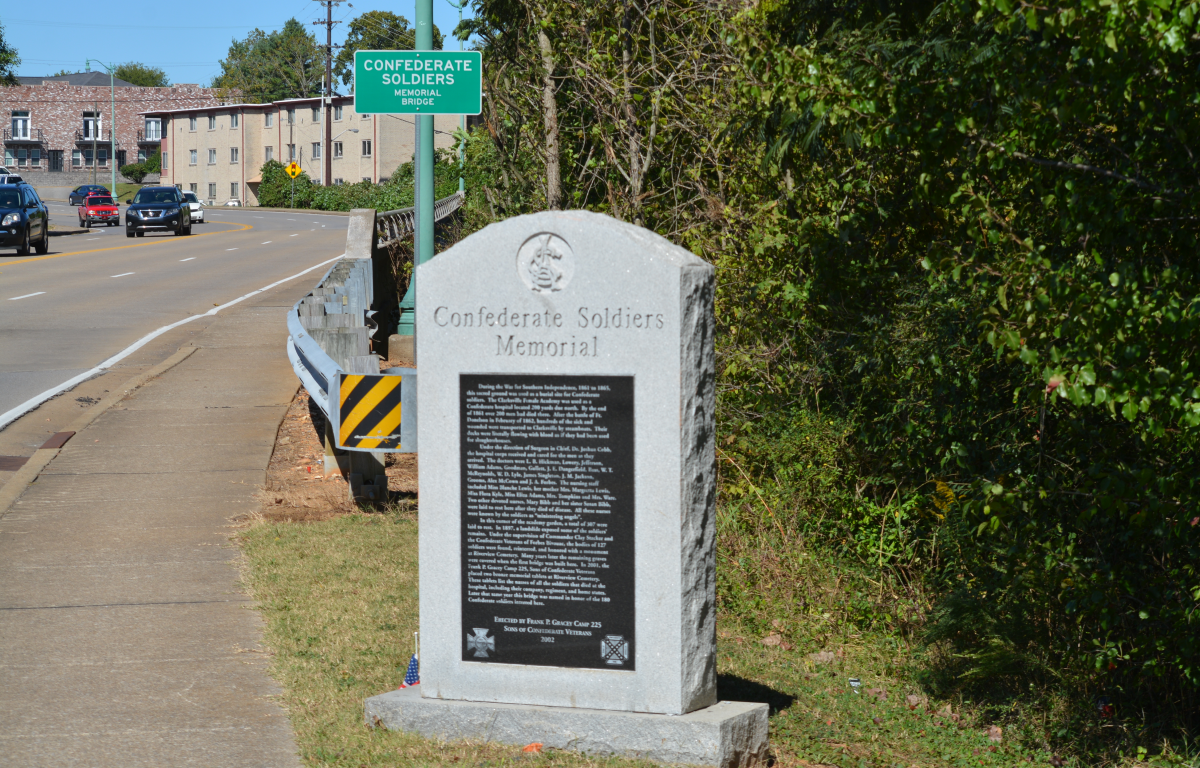CLARKSVILLE, Tenn. (CLARKSVILLENOW) – Signage for the Confederate Soldiers Memorial Bridge and the corresponding monument have both returned to their previous locations after spending a few months in storage.
Almost 20 years ago, the sign and memorial were erected on Cumberland Drive by the Frank P. Gracey Camp 225 of the Sons of Confederate Veterans. The bridge dedication was approved by a 7-4 vote of the Clarksville City Council in August 2001.
Both were removed back in June. The decision to do so, made by Clarksville Mayor Joe Pitts, was directly related to the growth of social justice movement Black Lives Matter. While peaceful protests took place in Clarksville for 93 consecutive days on Wilma Rudolph Boulevard, outrage on both sides translated into an uptick of violence across the county.
“I made the decision to remove and store the monument and sign in early June, out of an abundance of caution during the heat of the George Floyd-related demonstrations. I didn’t want them to be vandalized or become a flashpoint,” Pitts told Clarksville Now this week.
However, the mayor said the end of the local demonstrations and the recent return of the Confederate memorials were purely happenstance and unrelated.
The mayor also said he never talked to local Black Lives Matter activists about removing or returning the monument and sign.
Civil War hospital burial site
Gary Libiano, commander of Frank P. Gracey Camp 225, told The Leaf-Chronicle in June that the monument was “nothing more than a grave marker.”
A mass burial site is located at the former home of Clarksville Female Academy, which was repurposed as a hospital during the Civil War. Years later, after erosion in the area, many of the dead were moved and interned at Riverview Cemetery, according to newspaper archives. But up to 200 people may still be buried there, Libiano has said.
The monument itself tells the history of the site, and inscribed on the monument are the names of doctors who worked at the hospital, which includes two Black nurses, sisters Mary and Susan Bibb. They were also buried at the hospital after dying of disease. It is unclear whether they were moved with those interned at Riverview or still remain at the site.
Libiano’s attorney, H. Edward Phillips, who is working with the city on a solution for how to handle the monument, said both Confederate and Union soldiers were treated at the hospital and buried at the site.
However, the monument doesn’t mention that, it focuses on the Confederate soldiers, and it’s titled “Confederate Soldiers Memorial.” It’s also decorated with symbols of the Confederacy.
And, while the monument may be intended only as a grave marker, Frank P. Gracey Camp 225 has this purpose statement listed on the group’s website. It was given by Lt. Gen. Stephen Dill Lee during a speech in 1906:
“To you, Sons of Confederate Veterans, we will commit the vindication of the cause for which we fought. To your strength will be given the defense of the Confederate soldier’s good name, the guardianship of his history, the emulation of his virtues, the perpetuation of those principles which he loved and which you love also, and those ideals which made him glorious and which you also cherish.”
“Stephen Dill Lee, when he gave that charge in 1906, he wasn’t saying that you now go out and try to re-enslave everybody. That’s not what he was saying,” Phillips said when asked about this quote.
“The backdrop is this chattel slavery issue, because it drove the economy, but for them at that time, in 1906, they weren’t saying, ‘Go forth and approach everyone who is not like you,'” Phillips continued. “What they were saying is remember the virtues that they did have, as imperfect as man is, remember the things that were actually good.”
Tangled Civil War history
Phillips himself is embroiled in this issue on a personal level: Some of his ancestors fought on the side of the Union during the Civil War, and those of his family who were conscripted into the Confederate army did so unwillingly, he said.
When asked about the Confederacy’s desire to uphold slavery, Phillips said the issue was more complex than that singular aspect.
“Do you really believe people alive in the 21st century want to go back to the days during the 1850s?” Phillips asked.
Verifiably, there are those who refuse to denounce white supremacy, and in fact embrace it, although Phillips said they are in the vast minority.
“If we are going to sit back and say everybody in this country harbors a sentiment such as that, or a large number of people harbor a sentiment such as that, then what holds us together as a nation?” Phillips said.
Legal discussions under way
When Clarksville Now asked the mayor about the group’s purpose statement, Pitts made clear that installing the monument wasn’t his idea.
“Let me just say the decision to place the monument and name the bridge was made by the City Council in the early 2000s, long before I was elected mayor. So this is a situation I inherited, and I’m trying to manage it and get an appropriate outcome for the City,” Pitts said.
Libiano, on behalf of Clarksville’s chapter of the Sons of Confederate Veterans, and the city are in legal discussions to determine what to do with the monument and bridge sign. While there are talks among some in Clarksville’s government to possibly rename the bridgeor remove the monument, that decision is not for Pitts to make.
“The monument is protected under the Tennessee Heritage Protection Act, so any redesignation or removal of the monument would have to be approved by the Tennessee Historical Commission. Our city attorney continues to seek a legal settlement with the Sons of Confederate Veterans in regard to the monument and the bridge,” Pitts said.


